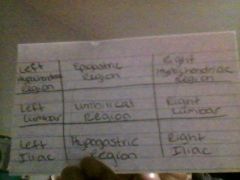![]()
![]()
![]()
Use LEFT and RIGHT arrow keys to navigate between flashcards;
Use UP and DOWN arrow keys to flip the card;
H to show hint;
A reads text to speech;
33 Cards in this Set
- Front
- Back
- 3rd side (hint)

|

|
|
|
|
Proximal VS Distal |
Proximal: close to point of origin Distal: away from point of origin |
|
|
|
Gross |
Can be seen with naked eye -Systemic: whole systems -Regional: specific areas of the body |
2 types |
|
|
Pathological |
Study of structure changes due to disease |
|
|
|
Microscopic Structures in the body |
-Chemical -Cellular -Tissue |
3 kinds |
|
|
Dorsal Body Cavity |
-Cranial Cavity: Brain -Vertebral Cavity: Spinal Cord |
2 Structures |
|
|
Membranes in the Dorsal Cavity |
-Pleural: Thoracic cavity (lungs) -Pericardium: Heart cavity -Peritoneum: Abdomino-pelvic cavity |
3 types |
|
|
Thoracic Cavity Divisions |
R & L pleural cavity -lungs Mediastinum -space between the lungs |
2 |
|
|
Medial VS Lateral |
Medial: towards middle of the body Lateral: towards side of body |
|
|
|
Superficial VS Deep |
Superficial: close to the surface Deep: deeper inside the surface |
|
|
|
Structural Organization |
-Chemical -Cellular -Tissue -Organs -Systems -Organism |
6 structures |
|
|
Divisions of the Human Body |
-Cytology -Histology -Gross -Topographical -Pathological |
|
|
|
Ventral Body Cavity |
Thoracic Cavity -Heart & Lungs Abdomino-pelvic Cavity -Abdomen & Pelvis |
|
|
|
Parietal VS Visceral |
Parietal: towards the wall -closer to the skin Visceral: towards the organ |
|
|
|
Anatomical Guide |
Using an external structure of the body to locate an internal one |
|
|
|
Peripheral VS Central |
Peripheral: away from the center/core of the body Central: middle of the body, closer to the core |
|
|
|
Ipsilateral VS Contralateral |
Ipsilateral: structures are on the same side of the body Contralateral: structures are on opposite sides of the body |
|
|
|
Anatomy VS Physiology |
Anatomy: structure & form Physiology: function |
|
|
|
Chemical Make-up of the Body |
-Hydrogen -Oxygen -Nitrogen -Calcium |
|
|
|
Topographical |
Using body landmarks to determine structures inside the body |
|
|
|
Histology |
Study of tissues |
|
|
|
Cytology |
Study of cells |
|
|
|
Anatomical Position |
-Standing upright -Head & Palms facing forward -Legs shoulder-width apart |
|
|
|
Anterior VS Posterior |
Anterior aka Ventral -towards the front of the body Posterior aka Dorsal -towards the back of the body |
|
|
|
Superior VS Inferior |
Superior: towards the top Inferior: towards the bottom |
|
|
|
Cephalic VS Caudal |
Cephalic: towards the head Caudal: towards the tail or butt |
|
|
|
Internal VS External |
Internal: inside the body External: outside the body |
|
|
|
Supine VS Prone |
Supine: laying face up Prone: laying face down |
|
|
|
Horizontal (Transverse) Plane |
Dividing top & bottom of body |
|
|
|
Frontal (Coronal) Plane |
Separates front & back of body |
|
|
|
Sagittal Plane and Mid-Sagittal Plane |
Sagittal: separates R & L sides Mid-sagittal: separates R & L sides equally |
|
|
|
Anatomical Limits |
Start/Stop coordinates to find internal structures |
|
|
|
Linear Guides |
Imaginary lines for the body |
|

